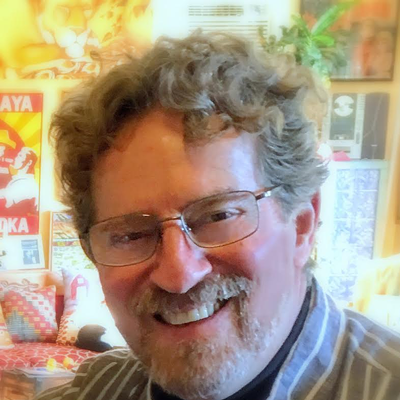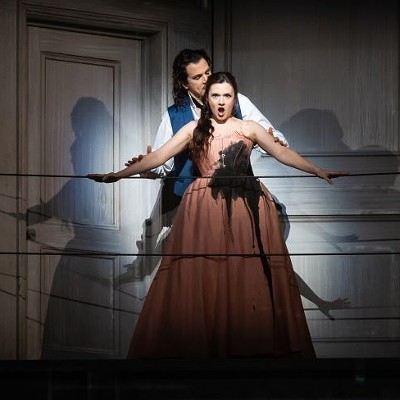The setup:
The three characters who collide with each other like subatomic particles in Michael Frayn's award-winning deep-dish science play Copenhagen (1998) are dead from the start, ghostly presences in a shadowy limbo. That they manage to come alive in fits and pieces is due to the probing chemistry between the actors, the physical fluidity of director Guy Roberts and the behind-the-scenes wizards at Main Street Theater: John Smetar with autumnal lighting and Jacob C. Sanchez with subtle sound work. Playwright Frayn has almost nothing to do with it.
The execution:
The most exciting passages, the ones that grab us and shake us awake, that have us straining forward to comprehend every word, are the driest topics imaginable – quantum mechanics, the wave theory, nuclear fission, cloud chambers, complementarity, the physics of physics. Everyone comes alive onstage when they debate, argue, expostulate on such weighty unknowns. We enjoy this too. It's like the best physics class for those of us who wouldn't know a positron from a meson.
However, atomic particles get all Frayn's love. What's left is a dusty personal mystery about why these particular three are here at all. “But why did he come to Copenhagen?” asks a wary Margrethe in the play's first line.
Her husband, Niels Bohr, Nobel prize winner in physics (1922), was the world's pre-eminent theoretical physicist. But once he and others had bored into the uranium atom to discover its unstoppable energy, the race was on to unleash it. Scientists may live in ivory towers, but world despots live close to the ground. Put such annihilating strength in a bomb, and they conquer the world – or, the other ones with better angels in their nature will stop those who would. The ultimate weapon.
Around Bohr sat a coterie of bright young men who worshiped the Dane. Werner Heisenberg (a future Nobel prize winner), a German, was his star pupil. Like father and son. Discovery after discovery poured from Bohr's think tank in the late '20s and early '30s. Together they hiked, skied, played ping-pong and poker. Competitors and family, the young pup and the “Pope.” But Heisenberg went back to Germany for a prestigious teaching post and, when Hitler seized power, he stayed where he was. He worked for the Nazis, and they expected a bomb. Unfortunately, they detested theorists as airy-fairy, not masculine, too Jewish. The lucky ones escaped or emigrated, either to Bohr's institute in Copenhagen, or to Britain and America. After political consequences were shelved (he was much too important to ignore or demote), Heisenberg rose to the highest echelon in Germany's nuclear program, the infamous Uranium Club.
It's 1941. Denmark has been conquered and occupied. Gestapo spies lurk everywhere. Bohr, half-Jewish, fears for his family's safety. There are rumors of deportation. Former acolyte Heisenberg visits Copenhagen for a lecture and wants to see Bohr. But he's the enemy; why has he come and what does he want from his mentor? These questions propel the play, and after the first uneasy confrontation, there's no satisfactory answer.
The three characters reposition their chairs. The set's minimal. Banners hang from the ceiling, where equations or out-of-focus movement that looks like particles in a reactor are projected. The three meet again, only with subtle variables this time because of information gleaned during the previous scene. Time shifts. They meet again, and again.
More is revealed, more motives discussed, more painful memories dredged from “the darkness inside the human soul,” in one of Frayn's more ominously hoary descriptions. Larded with intriguing scientific jargon, the specters trudge onward.
So why did he come? Was Heisenberg a spy, seeking hints of the Allies' nuclear program? Is he a “dear friend” come to warn Bohr before it's too late? Or does he seek atonement for his work with the despised Nazis? Is Bohr implicit in this rush to madness, too, since he would eventually be a “father figure” at Los Alamos, New Mexico, the research lab where the Allies successfully created the H-bomb? Historians have been debating these imponderables since the visit, and even the most recently unearthed letters and diaries have not satisfactorily explained exactly what happened that September evening in Copenhagen.
The play is rich, meaty and tongue-twisting in its complexities of science. Thank goodness for Margrethe, and Celeste Roberts's tartly delivered performance. She's our stand-in, the play's conscience. When the two physicists go off on their arcane particle tangents, she's the one they explain everything to, “so that she can understand.” It's condescending, no doubt, but without her we'd be gloriously lost. She's suspicious of Heisenberg from the start. For all their shared early history together, she never trusts him. Taut but composed, devoted to her husband, a loyal amanuensis, she's been wounded and shows it in her posture, how she sits on the chair, how she clasps her hands. She smolders. There's fire beneath, but banked.
As Niels Bohr, the old man of science, Joel Sandel is stooped under the burden of ethics and social responsibility. His brown pin-stripe suit might be baggy, but he's still a lion. He imbues Bohr with intellect in reserve. We can see him think. He still loves his star pupil; you notice that in his sympathetic glance even when put off by Heisenberg's youthful intransigence and amoral excuses for aiding the enemy, and he aches when talking about his dead son and his futile efforts to save him. Racked by guilt, he doesn't deserve the moral equivalency Frayn heaps on him near the end for his role in Hiroshima. Frayn's thinking is most dubious here (and his theory spurious), for Sandel exudes moral rectitude.
Philip Hays keeps Heisenberg's once-youthful edginess in counterpoint, or is that “complementarity?” When he steps into his pool of light, his face blazes with an aura that looks positively medieval, a profane saint who's discovered the movement of the spheres or, perhaps, a wayward alchemist spinning straw into gold. He keeps his secrets hidden under a veneer of righteousness and boyish charm. Did he thwart the Nazis' experiments by intentionally miscalculating the necessary equation? Was he unconsciously vague? Blithely mistaken? Hays plays it with mesmerizing ambivalence.
The verdict:
The drama swirls with “complementary” facts that are neither right nor wrong, but depicts the way we react like particles, colliding with one another and thereby altering our lives in unknowable ways. But atoms have no morals.
There are two scenes where warmth floods the stage and we glimpse the human heart: Heisenberg's monologue about his love for Germany, warts and all; and Bohr's unending guilt over the death of his son. Action and consequence. These vignettes knock these lofty thinkers down to our level, make them real, not bickering phantoms. This is Frayn at his most poignant, when he solidly proves what's most important. For all the textbook theories, we're more unpredictable than any atom. The farther we delve into ourselves, into others, the more mysteriously elusive we become. The human spirit is more enduring, more powerful and more unfathomable than any bomb.
Copenhagen continues at.7:30 p.m. Thursdays, Fridays and Saturdays; 3 p.m. Sundays. Through March 12 at Main Street Theater, 2540 Times. For information, call 713-524-6706 or visit mainstreettheater.com. $20 to $45.
Support Us
Houston's independent source of
local news and culture
account
- Welcome,
Insider - Login
- My Account
- My Newsletters
- Contribute
- Contact Us
- Sign out

Philip Hays, Celeste Roberts and Joel Sandel in Copenhagen at Main Street Theater.
Photo by Pin Lim
[
{
"name": "Related Stories / Support Us Combo",
"component": "11591218",
"insertPoint": "4",
"requiredCountToDisplay": "4"
},{
"name": "Air - Billboard - Inline Content",
"component": "11591214",
"insertPoint": "2/3",
"requiredCountToDisplay": "7"
},{
"name": "R1 - Beta - Mobile Only",
"component": "12287027",
"insertPoint": "8",
"requiredCountToDisplay": "8"
},{
"name": "Air - MediumRectangle - Inline Content - Mobile Display Size 2",
"component": "11591215",
"insertPoint": "12",
"requiredCountToDisplay": "12"
},{
"name": "Air - MediumRectangle - Inline Content - Mobile Display Size 2",
"component": "11591215",
"insertPoint": "4th",
"startingPoint": "16",
"requiredCountToDisplay": "12"
}
,{
"name": "RevContent - In Article",
"component": "12527128",
"insertPoint": "3/5",
"requiredCountToDisplay": "5"
}
]
KEEP THE HOUSTON PRESS FREE...
Since we started the Houston Press, it has been defined as the free, independent voice of Houston, and we'd like to keep it that way. With local media under siege, it's more important than ever for us to rally support behind funding our local journalism. You can help by participating in our "I Support" program, allowing us to keep offering readers access to our incisive coverage of local news, food and culture with no paywalls.
D.L. Groover has contributed to countless reputable publications including the Houston Press since 2003. His theater criticism has earned him a national award from the Association of Alternative Newsmedia (AAN) as well as three statewide Lone Star Press Awards for the same. He's co-author of the irreverent appreciation, Skeletons from the Opera Closet (St. Martin's Press), now in its fourth printing.
Contact:
D. L. Groover
Trending Arts & Culture
- The 10 Best And Most Controversial Hustler Magazine Covers Ever (NSFW)
- Whose Story is It in The Father at 4th Wall Theatre Co.
- Top 5 Sickest Stephen King Sex Scenes (NSFW)
-
Sponsored Content From: [%sponsoredBy%]
[%title%]

Don't Miss Out
SIGN UP for the latest
arts & culture
news, free stuff and more!
Become a member to support the independent voice of Houston
and help keep the future of the Houston Press FREE
Use of this website constitutes acceptance of our
terms of use,
our cookies policy, and our
privacy policy
The Houston Press may earn a portion of sales from products & services purchased through links on our site from our
affiliate partners.
©2024
Houston Press, LP. All rights reserved.





